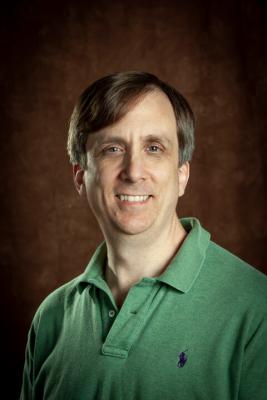 Menu
Menu

By Maureen Horan Benes, BA ’03
We sat down with Chairman of Mathematics John Osoinach, Ph.D., to discuss his new textbook, Discovering Abstract Algebra.
My textbook is designed for a type of teaching called Inquiry-Based Learning (IBL).
Most other abstract algebra textbooks are written for classes in which instructors provide proofs of the theorems, and then student exercises mimic what they already saw in class. My book requires students to prove all of the theorems without having an instructor first provide proofs. The exercises motivate the theorems students are about to prove and give applications for what they just proved.
There were three main sources. First, the Mathematical Association of America (MAA) has very broad guidelines and recommendations for what topics an Abstract Algebra course should cover, and I used that as a foundation for choosing what to include in my book. Second, I drew inspiration from well-known textbooks for effective ordering of those topics, but I adapted that ordering in many places to accommodate the IBL style of the book. Finally, my experience with UD students played a central role in determining the “scaffolding” of the theorem sequence. Specifically, I learned from them how much (or little) they needed to know or prove about one topic before proving theorems in the next.
Without the department at UD that encourages this style of teaching, the book itself would never have been possible. Dr. Paul Phillips taught from the book for a semester, and his experiences improved the second half of the book. Our postdoctoral fellows taught from early drafts of the book, so their feedback also helped me refine and rewrite. But the students were really the most important guides in writing. I learned from them where they needed more structure or insight, where they didn’t really need as much detail as I thought, and where particular exercises or examples really made a difference in their understanding.
The audience is undergraduate math majors at any four-year institution with a degree in mathematics. Abstract Algebra is a required course for nearly all B.A. and B.S. degrees in mathematics, unless an institution has an applied math major or track. It’s also one of the most anxiety-producing courses, as it’s very theoretical and a subject with which hardly any math major is familiar.
The main difference for me was thinking about the audience that would read the publication. Writing a textbook for instructors and students in an IBL setting required me to think about how the book would be experienced in the classroom. I thought about this book from a storytelling perspective: I needed main characters (the algebraic objects and structures), a plot (the theme of the book is how to solve equations), and a narrative that furthers the plot (the theorems, new definitions, unexpected examples provide the drama). The result is a book that’s honestly readable, at least for math majors.
It was an absolutely wonderful experience. The MAA is a nonprofit, professional society that has very high standards for its books, and mine went through several stages of scrutiny. The acquisitions editor gave it a first read and made some incredibly important suggestions before I sent it to the entire editorial board. The book was then reviewed by six active mathematicians, all of whom gave specific feedback on areas that needed improvement. The result of this careful review and editing was a book far better than I could have realized on my own.
Discovering Abstract Algebra is available through the AMS Bookstore and amazon.com.